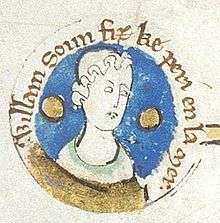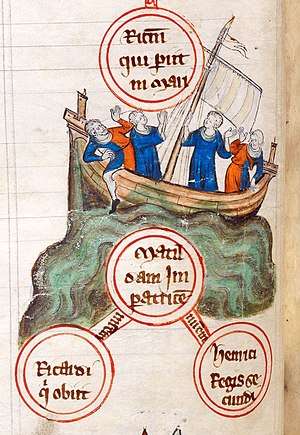William Adelin
William Ætheling (Old English: [ˈwiɫiɑm ˈæðeliŋg]; 5 August 1103 – 25 November 1120), commonly called Adelin, sometimes Adelinus, Adelingus, A(u)delin or other Latinised Norman-French variants of Ætheling,[1] was the son of Henry I of England by his wife Matilda of Scotland, and was thus heir apparent to the English throne. His early death without issue caused a succession crisis, known in history as the Anarchy.
| William Adelin | |
|---|---|
| Duke of Normandy | |
 | |
| Born | 5 August 1103 Winchester, Hampshire, England |
| Died | 25 November 1120 (aged 17 years) near Barfleur, Normandy |
| Spouse | |
| House | Normandy |
| Father | Henry I of England |
| Mother | Matilda of Scotland |
Early life
William was born in Winchester. His father, Henry I of England, had married his mother, Matilda of Scotland, to conciliate his English subjects. Matilda was descended from Edmund Ironside and was a great-niece of Edward the Confessor; as such, the marriage represented a union between the new Norman rulers of England and the old Anglo-Saxon dynasty. Moreover, she was the daughter of the king Malcolm III "Canmore" of Scotland and Queen Margaret, who was an Anglo-Saxon princess; the marriage further united Scotland to the English throne.
Henry's hopes for his succession rested upon William, who was, according to Henry of Huntingdon, "a prince so pampered" that he seemed "destined to be food for the fire."[2]
Duke of Normandy
During Henry I's lifetime, William was invested as Duke of Normandy, a title he held more in name than in practice. Henry made the investiture when he was pressed by the king of France, Louis VI, to do homage as Duke of Normandy. As a king in his own right, Henry was loath to comply, and in 1115 he offered to have William do this in his stead. This offer was eventually accepted in 1120, after an intervening period of war, and William did homage to Louis VI in the middle of 1120. For this reason William is sometimes counted as Duke of Normandy (as either William III or William IV).[3] William received, as the heir to the throne, the homage and fealty of the barons of Normandy in 1115 and of the barons of England in March 1116.[4]
William's mother Queen Matilda served as Henry's regent in England while he was away in Normandy. After her death in 1118 William was old enough to serve in her stead. He was closely advised in this role by the King's administrators, such as Roger of Salisbury. During the last year or so of his life he was sometimes referred to as rex designatus (king designate).
During his 35-year reign Henry I of England would face several eruptions of hostilities due to the alliances of rival regions with some of his neighbours. To secure the loyalty of Anjou, a long-time rival of Normandy, Henry betrothed William to Matilda of Anjou, eldest daughter of Count Fulk V of Anjou in February 1113 near Alençon.[4] The marriage finally took place in June 1119 in Lisieux.[4]
Death

William died in the White Ship tragedy of 25 November 1120. The Duke and his companions had been crossing the English Channel from Barfleur in the Blanche-Nef, the swiftest and most modern ship in the royal fleet. William and his party had remained drinking on the shore until after dark, confident that in a fast ship and on the still sea the delay would have no real effect. Consequently, it was the middle of the night when the drunken helmsman rammed the ship into a rock in the bay. The crew and passengers could not lever the ship off the rock, or prevent the ship from filling with water; however, William and several of his friends managed to launch a life-dinghy. At the last minute, William dashed back to rescue his illegitimate half-sister, Matilda FitzRoy, Countess of Perche; when they and several others threw themselves into the small dinghy, it, "overcharged by the multitude that leapt into her, capsized and sank and buried all indiscriminately in the deep."[5]
Henry of Huntingdon, speaking of the disaster, wrote that William, "instead of wearing embroidered robes…floated naked in the waves, and instead of ascending a lofty throne…found his grave at the bottom of the sea."[6]
William's wife, Matilda, was on another ship at the time of the wreck. After remaining at Henry I's court for a time (where she was treated as a daughter), she did not remarry. Matilda returned to Anjou and later became a nun. Eventually she was made Abbess of Fontevraud Abbey in 1150. Matilda died almost 30 years after the White Ship tragedy.
Aftermath
William's death ruined his father's hopes and policies. Although he made a hasty second marriage (Matilda of Scotland had died in 1118) to Adeliza of Louvain, Henry did not produce any more legitimate children. With no clear male heir (the obvious choice, William Clito, the son of Henry's older brother Robert Curthose, was not favoured by the King; Henry had an abundance of other nephews and illegitimate children, of whom his favoured nephew Stephen of Blois—son of Henry's sister Adela—and his illegitimate son Robert of Gloucester particularly stood out, but for various reasons none were chosen), Henry designated his daughter, the dowager empress Matilda, as his heiress, marrying her to William's brother-in-law Geoffrey V, Count of Anjou, and forcing his barons to swear to uphold her rights. On his death, the barons reneged on their oaths on the grounds of coercion, and chose Henry's nephew, Stephen of Blois, prompting a period of English history known as The Anarchy.
Notes
- "Adelin" derives from the Germanic element Adel, meaning "noble", and is equivalent to the Old English word Æthel, "noble". Adelinus is thus equivalent to the term "Ætheling" used for English princes prior to the Norman Conquest. The Latin term Clito (meaning "noble") was sometimes used instead: for example in the case of William Adelin's cousin, William Clito. See Miller, S., "Ætheling" in The Blackwell Encyclopaedia of Anglo-Saxon England, ed. M. Lapidge, J. Blair, S. Keynes and D. Scragg. Oxford: Blackwell, 2003. ISBN 0-631-22492-0.
- Meade, Marion, Eleanor of Aquitaine.
- William Clito, son of Robert Curthose and William's first cousin, is also sometimes designated 'Duke of Normandy'.
- J. F. A. Mason, ‘William (1103–1120)’, Oxford Dictionary of National Biography, Oxford University Press, 2004
- William of Malmesbury, from Marion Meade, Eleanor of Aquitaine.
- Henry of Huntingdon, quoted in Eleanor of Aquitaine, Meade, Marion.
References
- Hollister, C. Warren. Henry I (Yale Monarchs Series)
- Meade, Marion, Eleanor of Aquitaine
- . Dictionary of National Biography. London: Smith, Elder & Co. 1885–1900.
William Adelin House of Normandy Born: 5 August 1103 Died: 25 November 1120 | ||
| Regnal titles | ||
|---|---|---|
| Preceded by Henry I |
Duke of Normandy 5 August – 25 November 1120 |
Succeeded by Henry I |